Interprofessional Practice: Self-Reflection, Clinical Question, Prioritization and Professional Management
VerifiedAdded on 2023/06/15
|10
|2880
|227
AI Summary
This article discusses interprofessional practice in nursing, covering self-reflection, clinical question, prioritization, and professional management. It includes a discussion on the RMH’s graduate program for nurses, immediate action for patient admitted for seizures investigation, and managing the situation for a patient who has been collected from the theatre. The subject is nursing, and the references include Apiradee, N. R. (2015) and Backstrom, B. S. (2016).
Contribute Materials
Your contribution can guide someone’s learning journey. Share your
documents today.
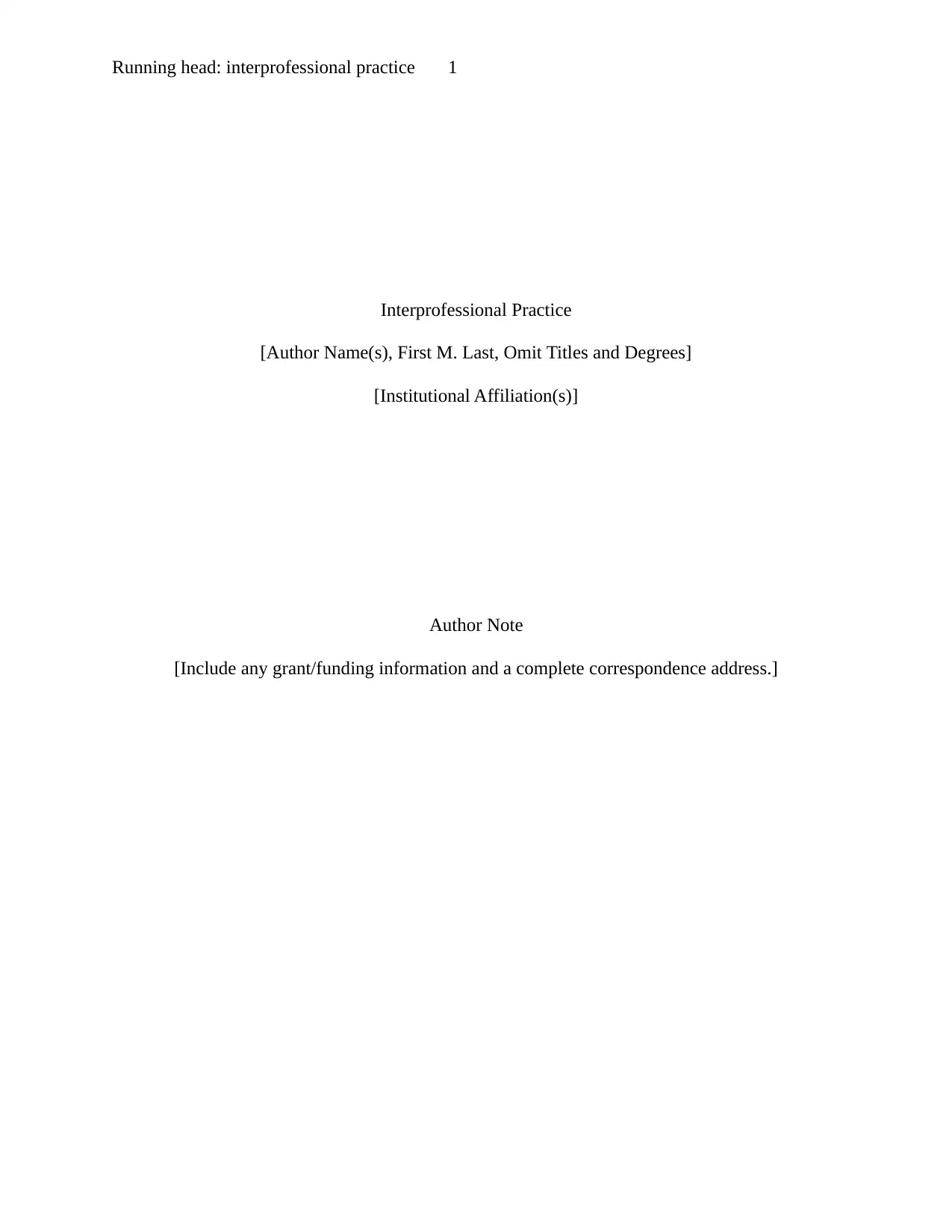
Running head: interprofessional practice 1
Interprofessional Practice
[Author Name(s), First M. Last, Omit Titles and Degrees]
[Institutional Affiliation(s)]
Author Note
[Include any grant/funding information and a complete correspondence address.]
Interprofessional Practice
[Author Name(s), First M. Last, Omit Titles and Degrees]
[Institutional Affiliation(s)]
Author Note
[Include any grant/funding information and a complete correspondence address.]
Secure Best Marks with AI Grader
Need help grading? Try our AI Grader for instant feedback on your assignments.
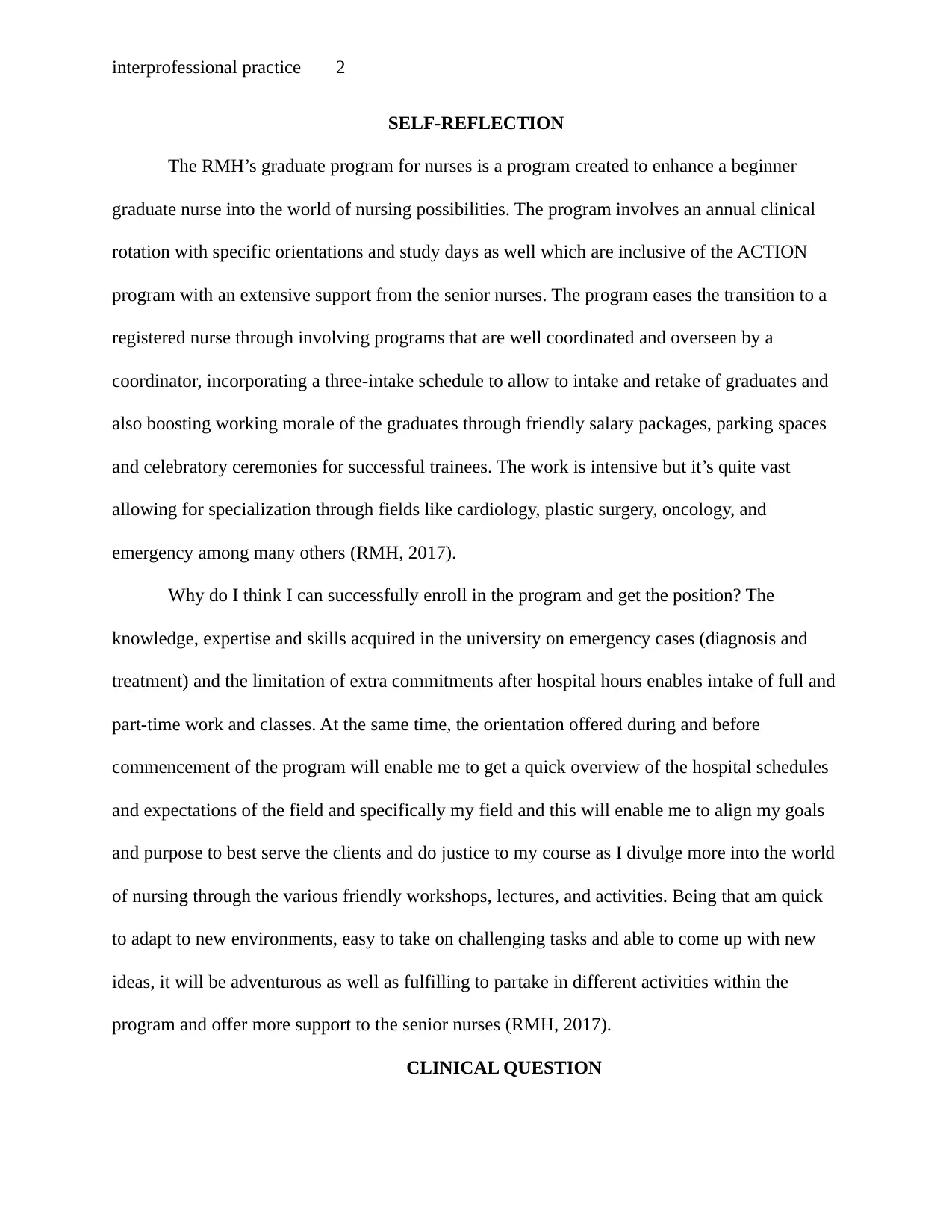
interprofessional practice 2
SELF-REFLECTION
The RMH’s graduate program for nurses is a program created to enhance a beginner
graduate nurse into the world of nursing possibilities. The program involves an annual clinical
rotation with specific orientations and study days as well which are inclusive of the ACTION
program with an extensive support from the senior nurses. The program eases the transition to a
registered nurse through involving programs that are well coordinated and overseen by a
coordinator, incorporating a three-intake schedule to allow to intake and retake of graduates and
also boosting working morale of the graduates through friendly salary packages, parking spaces
and celebratory ceremonies for successful trainees. The work is intensive but it’s quite vast
allowing for specialization through fields like cardiology, plastic surgery, oncology, and
emergency among many others (RMH, 2017).
Why do I think I can successfully enroll in the program and get the position? The
knowledge, expertise and skills acquired in the university on emergency cases (diagnosis and
treatment) and the limitation of extra commitments after hospital hours enables intake of full and
part-time work and classes. At the same time, the orientation offered during and before
commencement of the program will enable me to get a quick overview of the hospital schedules
and expectations of the field and specifically my field and this will enable me to align my goals
and purpose to best serve the clients and do justice to my course as I divulge more into the world
of nursing through the various friendly workshops, lectures, and activities. Being that am quick
to adapt to new environments, easy to take on challenging tasks and able to come up with new
ideas, it will be adventurous as well as fulfilling to partake in different activities within the
program and offer more support to the senior nurses (RMH, 2017).
CLINICAL QUESTION
SELF-REFLECTION
The RMH’s graduate program for nurses is a program created to enhance a beginner
graduate nurse into the world of nursing possibilities. The program involves an annual clinical
rotation with specific orientations and study days as well which are inclusive of the ACTION
program with an extensive support from the senior nurses. The program eases the transition to a
registered nurse through involving programs that are well coordinated and overseen by a
coordinator, incorporating a three-intake schedule to allow to intake and retake of graduates and
also boosting working morale of the graduates through friendly salary packages, parking spaces
and celebratory ceremonies for successful trainees. The work is intensive but it’s quite vast
allowing for specialization through fields like cardiology, plastic surgery, oncology, and
emergency among many others (RMH, 2017).
Why do I think I can successfully enroll in the program and get the position? The
knowledge, expertise and skills acquired in the university on emergency cases (diagnosis and
treatment) and the limitation of extra commitments after hospital hours enables intake of full and
part-time work and classes. At the same time, the orientation offered during and before
commencement of the program will enable me to get a quick overview of the hospital schedules
and expectations of the field and specifically my field and this will enable me to align my goals
and purpose to best serve the clients and do justice to my course as I divulge more into the world
of nursing through the various friendly workshops, lectures, and activities. Being that am quick
to adapt to new environments, easy to take on challenging tasks and able to come up with new
ideas, it will be adventurous as well as fulfilling to partake in different activities within the
program and offer more support to the senior nurses (RMH, 2017).
CLINICAL QUESTION
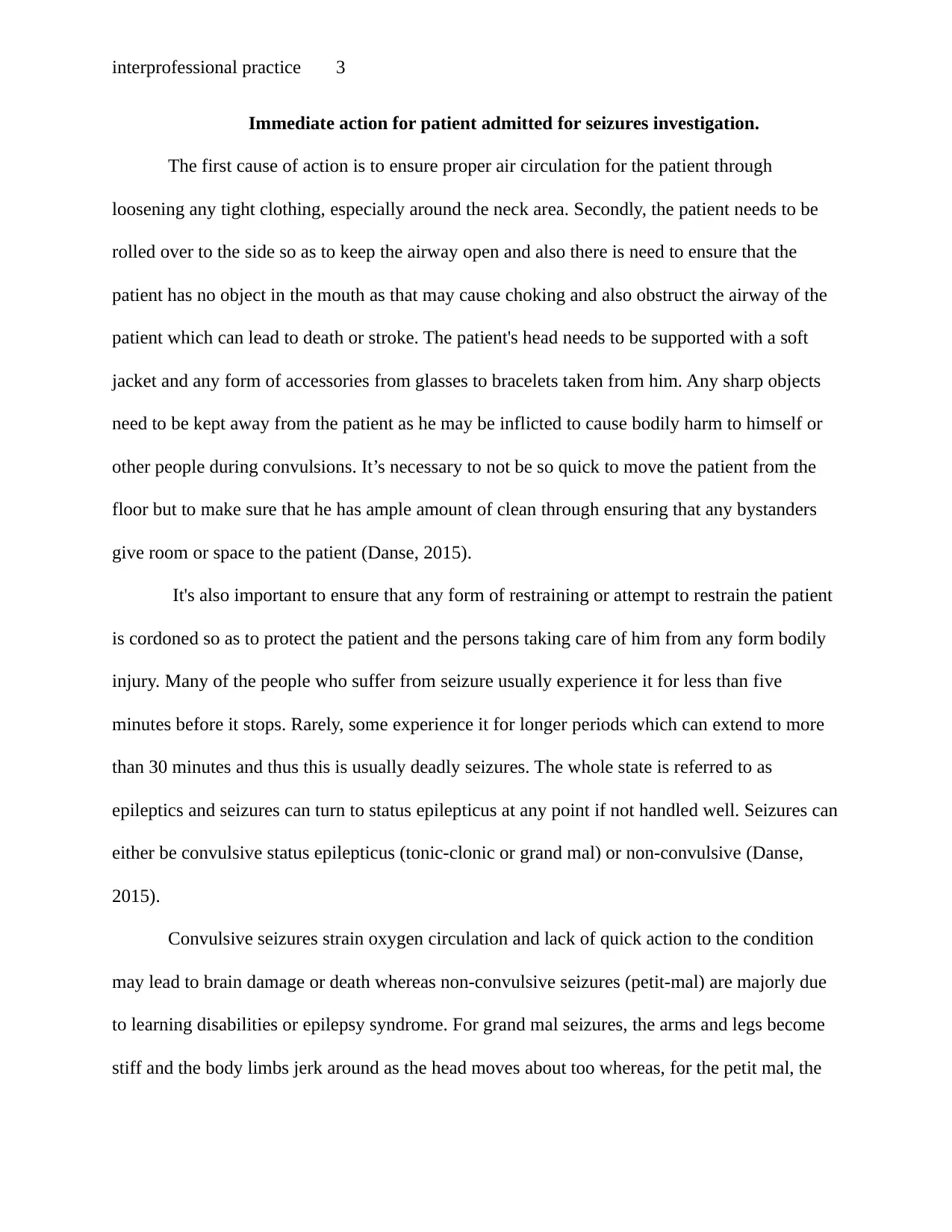
interprofessional practice 3
Immediate action for patient admitted for seizures investigation.
The first cause of action is to ensure proper air circulation for the patient through
loosening any tight clothing, especially around the neck area. Secondly, the patient needs to be
rolled over to the side so as to keep the airway open and also there is need to ensure that the
patient has no object in the mouth as that may cause choking and also obstruct the airway of the
patient which can lead to death or stroke. The patient's head needs to be supported with a soft
jacket and any form of accessories from glasses to bracelets taken from him. Any sharp objects
need to be kept away from the patient as he may be inflicted to cause bodily harm to himself or
other people during convulsions. It’s necessary to not be so quick to move the patient from the
floor but to make sure that he has ample amount of clean through ensuring that any bystanders
give room or space to the patient (Danse, 2015).
It's also important to ensure that any form of restraining or attempt to restrain the patient
is cordoned so as to protect the patient and the persons taking care of him from any form bodily
injury. Many of the people who suffer from seizure usually experience it for less than five
minutes before it stops. Rarely, some experience it for longer periods which can extend to more
than 30 minutes and thus this is usually deadly seizures. The whole state is referred to as
epileptics and seizures can turn to status epilepticus at any point if not handled well. Seizures can
either be convulsive status epilepticus (tonic-clonic or grand mal) or non-convulsive (Danse,
2015).
Convulsive seizures strain oxygen circulation and lack of quick action to the condition
may lead to brain damage or death whereas non-convulsive seizures (petit-mal) are majorly due
to learning disabilities or epilepsy syndrome. For grand mal seizures, the arms and legs become
stiff and the body limbs jerk around as the head moves about too whereas, for the petit mal, the
Immediate action for patient admitted for seizures investigation.
The first cause of action is to ensure proper air circulation for the patient through
loosening any tight clothing, especially around the neck area. Secondly, the patient needs to be
rolled over to the side so as to keep the airway open and also there is need to ensure that the
patient has no object in the mouth as that may cause choking and also obstruct the airway of the
patient which can lead to death or stroke. The patient's head needs to be supported with a soft
jacket and any form of accessories from glasses to bracelets taken from him. Any sharp objects
need to be kept away from the patient as he may be inflicted to cause bodily harm to himself or
other people during convulsions. It’s necessary to not be so quick to move the patient from the
floor but to make sure that he has ample amount of clean through ensuring that any bystanders
give room or space to the patient (Danse, 2015).
It's also important to ensure that any form of restraining or attempt to restrain the patient
is cordoned so as to protect the patient and the persons taking care of him from any form bodily
injury. Many of the people who suffer from seizure usually experience it for less than five
minutes before it stops. Rarely, some experience it for longer periods which can extend to more
than 30 minutes and thus this is usually deadly seizures. The whole state is referred to as
epileptics and seizures can turn to status epilepticus at any point if not handled well. Seizures can
either be convulsive status epilepticus (tonic-clonic or grand mal) or non-convulsive (Danse,
2015).
Convulsive seizures strain oxygen circulation and lack of quick action to the condition
may lead to brain damage or death whereas non-convulsive seizures (petit-mal) are majorly due
to learning disabilities or epilepsy syndrome. For grand mal seizures, the arms and legs become
stiff and the body limbs jerk around as the head moves about too whereas, for the petit mal, the
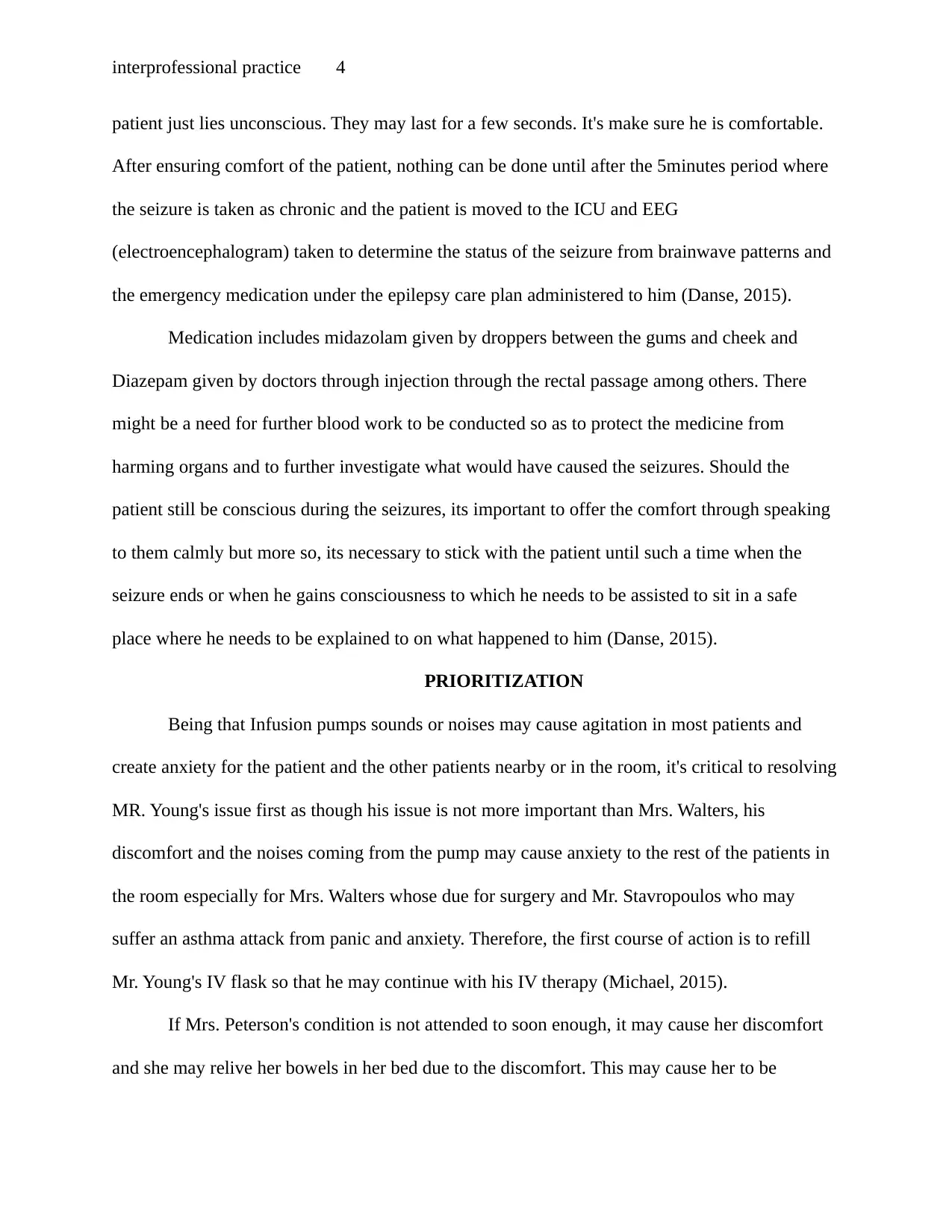
interprofessional practice 4
patient just lies unconscious. They may last for a few seconds. It's make sure he is comfortable.
After ensuring comfort of the patient, nothing can be done until after the 5minutes period where
the seizure is taken as chronic and the patient is moved to the ICU and EEG
(electroencephalogram) taken to determine the status of the seizure from brainwave patterns and
the emergency medication under the epilepsy care plan administered to him (Danse, 2015).
Medication includes midazolam given by droppers between the gums and cheek and
Diazepam given by doctors through injection through the rectal passage among others. There
might be a need for further blood work to be conducted so as to protect the medicine from
harming organs and to further investigate what would have caused the seizures. Should the
patient still be conscious during the seizures, its important to offer the comfort through speaking
to them calmly but more so, its necessary to stick with the patient until such a time when the
seizure ends or when he gains consciousness to which he needs to be assisted to sit in a safe
place where he needs to be explained to on what happened to him (Danse, 2015).
PRIORITIZATION
Being that Infusion pumps sounds or noises may cause agitation in most patients and
create anxiety for the patient and the other patients nearby or in the room, it's critical to resolving
MR. Young's issue first as though his issue is not more important than Mrs. Walters, his
discomfort and the noises coming from the pump may cause anxiety to the rest of the patients in
the room especially for Mrs. Walters whose due for surgery and Mr. Stavropoulos who may
suffer an asthma attack from panic and anxiety. Therefore, the first course of action is to refill
Mr. Young's IV flask so that he may continue with his IV therapy (Michael, 2015).
If Mrs. Peterson's condition is not attended to soon enough, it may cause her discomfort
and she may relive her bowels in her bed due to the discomfort. This may cause her to be
patient just lies unconscious. They may last for a few seconds. It's make sure he is comfortable.
After ensuring comfort of the patient, nothing can be done until after the 5minutes period where
the seizure is taken as chronic and the patient is moved to the ICU and EEG
(electroencephalogram) taken to determine the status of the seizure from brainwave patterns and
the emergency medication under the epilepsy care plan administered to him (Danse, 2015).
Medication includes midazolam given by droppers between the gums and cheek and
Diazepam given by doctors through injection through the rectal passage among others. There
might be a need for further blood work to be conducted so as to protect the medicine from
harming organs and to further investigate what would have caused the seizures. Should the
patient still be conscious during the seizures, its important to offer the comfort through speaking
to them calmly but more so, its necessary to stick with the patient until such a time when the
seizure ends or when he gains consciousness to which he needs to be assisted to sit in a safe
place where he needs to be explained to on what happened to him (Danse, 2015).
PRIORITIZATION
Being that Infusion pumps sounds or noises may cause agitation in most patients and
create anxiety for the patient and the other patients nearby or in the room, it's critical to resolving
MR. Young's issue first as though his issue is not more important than Mrs. Walters, his
discomfort and the noises coming from the pump may cause anxiety to the rest of the patients in
the room especially for Mrs. Walters whose due for surgery and Mr. Stavropoulos who may
suffer an asthma attack from panic and anxiety. Therefore, the first course of action is to refill
Mr. Young's IV flask so that he may continue with his IV therapy (Michael, 2015).
If Mrs. Peterson's condition is not attended to soon enough, it may cause her discomfort
and she may relive her bowels in her bed due to the discomfort. This may cause her to be
Secure Best Marks with AI Grader
Need help grading? Try our AI Grader for instant feedback on your assignments.
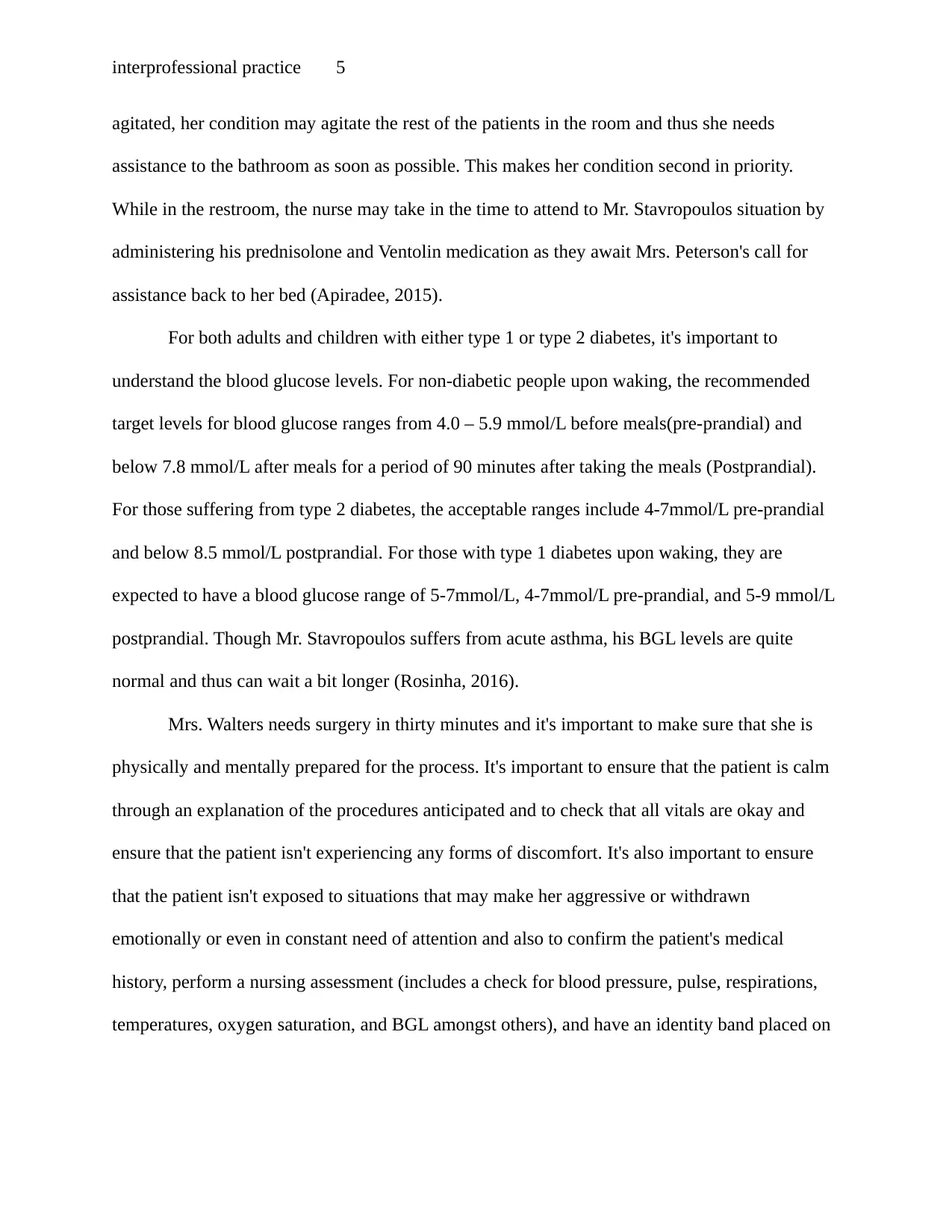
interprofessional practice 5
agitated, her condition may agitate the rest of the patients in the room and thus she needs
assistance to the bathroom as soon as possible. This makes her condition second in priority.
While in the restroom, the nurse may take in the time to attend to Mr. Stavropoulos situation by
administering his prednisolone and Ventolin medication as they await Mrs. Peterson's call for
assistance back to her bed (Apiradee, 2015).
For both adults and children with either type 1 or type 2 diabetes, it's important to
understand the blood glucose levels. For non-diabetic people upon waking, the recommended
target levels for blood glucose ranges from 4.0 – 5.9 mmol/L before meals(pre-prandial) and
below 7.8 mmol/L after meals for a period of 90 minutes after taking the meals (Postprandial).
For those suffering from type 2 diabetes, the acceptable ranges include 4-7mmol/L pre-prandial
and below 8.5 mmol/L postprandial. For those with type 1 diabetes upon waking, they are
expected to have a blood glucose range of 5-7mmol/L, 4-7mmol/L pre-prandial, and 5-9 mmol/L
postprandial. Though Mr. Stavropoulos suffers from acute asthma, his BGL levels are quite
normal and thus can wait a bit longer (Rosinha, 2016).
Mrs. Walters needs surgery in thirty minutes and it's important to make sure that she is
physically and mentally prepared for the process. It's important to ensure that the patient is calm
through an explanation of the procedures anticipated and to check that all vitals are okay and
ensure that the patient isn't experiencing any forms of discomfort. It's also important to ensure
that the patient isn't exposed to situations that may make her aggressive or withdrawn
emotionally or even in constant need of attention and also to confirm the patient's medical
history, perform a nursing assessment (includes a check for blood pressure, pulse, respirations,
temperatures, oxygen saturation, and BGL amongst others), and have an identity band placed on
agitated, her condition may agitate the rest of the patients in the room and thus she needs
assistance to the bathroom as soon as possible. This makes her condition second in priority.
While in the restroom, the nurse may take in the time to attend to Mr. Stavropoulos situation by
administering his prednisolone and Ventolin medication as they await Mrs. Peterson's call for
assistance back to her bed (Apiradee, 2015).
For both adults and children with either type 1 or type 2 diabetes, it's important to
understand the blood glucose levels. For non-diabetic people upon waking, the recommended
target levels for blood glucose ranges from 4.0 – 5.9 mmol/L before meals(pre-prandial) and
below 7.8 mmol/L after meals for a period of 90 minutes after taking the meals (Postprandial).
For those suffering from type 2 diabetes, the acceptable ranges include 4-7mmol/L pre-prandial
and below 8.5 mmol/L postprandial. For those with type 1 diabetes upon waking, they are
expected to have a blood glucose range of 5-7mmol/L, 4-7mmol/L pre-prandial, and 5-9 mmol/L
postprandial. Though Mr. Stavropoulos suffers from acute asthma, his BGL levels are quite
normal and thus can wait a bit longer (Rosinha, 2016).
Mrs. Walters needs surgery in thirty minutes and it's important to make sure that she is
physically and mentally prepared for the process. It's important to ensure that the patient is calm
through an explanation of the procedures anticipated and to check that all vitals are okay and
ensure that the patient isn't experiencing any forms of discomfort. It's also important to ensure
that the patient isn't exposed to situations that may make her aggressive or withdrawn
emotionally or even in constant need of attention and also to confirm the patient's medical
history, perform a nursing assessment (includes a check for blood pressure, pulse, respirations,
temperatures, oxygen saturation, and BGL amongst others), and have an identity band placed on
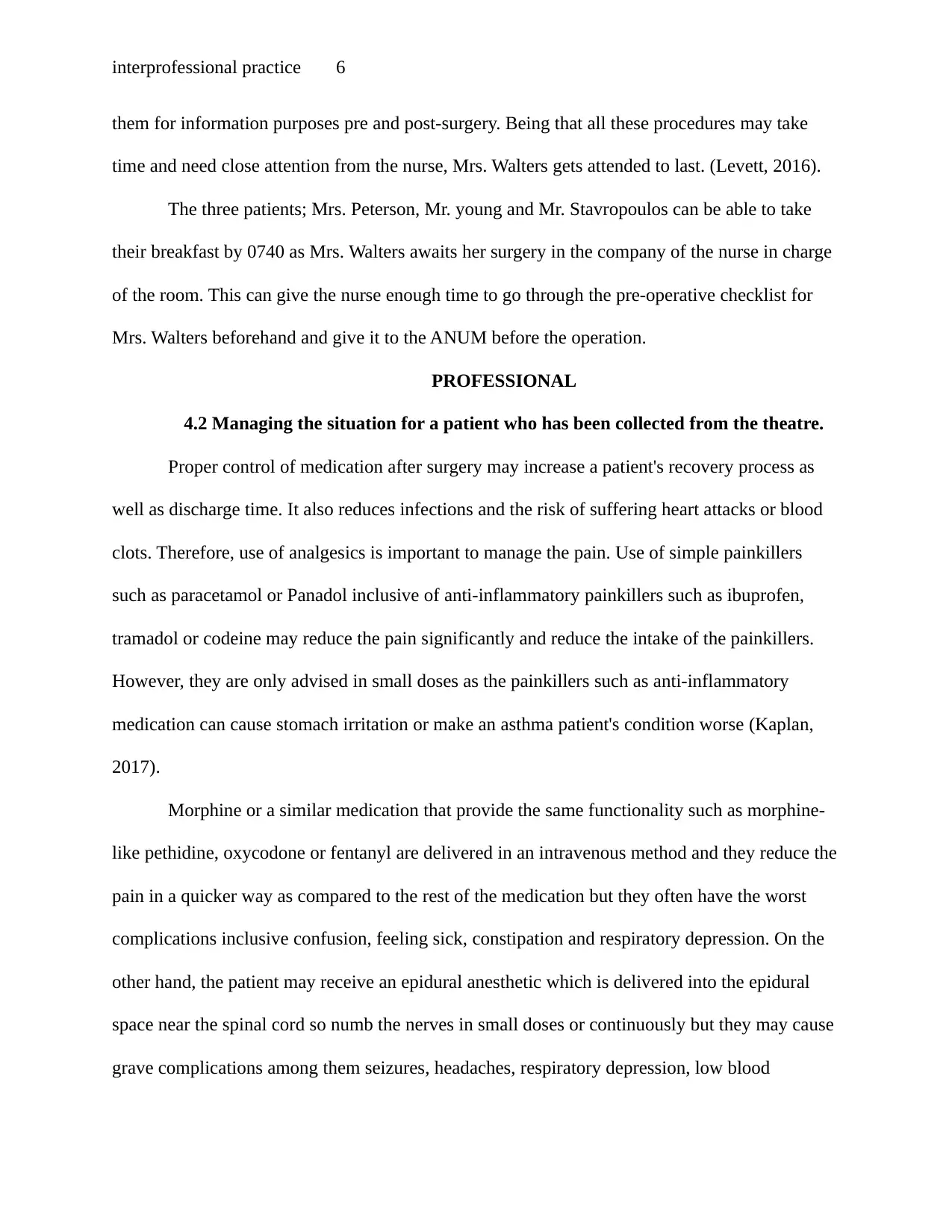
interprofessional practice 6
them for information purposes pre and post-surgery. Being that all these procedures may take
time and need close attention from the nurse, Mrs. Walters gets attended to last. (Levett, 2016).
The three patients; Mrs. Peterson, Mr. young and Mr. Stavropoulos can be able to take
their breakfast by 0740 as Mrs. Walters awaits her surgery in the company of the nurse in charge
of the room. This can give the nurse enough time to go through the pre-operative checklist for
Mrs. Walters beforehand and give it to the ANUM before the operation.
PROFESSIONAL
4.2 Managing the situation for a patient who has been collected from the theatre.
Proper control of medication after surgery may increase a patient's recovery process as
well as discharge time. It also reduces infections and the risk of suffering heart attacks or blood
clots. Therefore, use of analgesics is important to manage the pain. Use of simple painkillers
such as paracetamol or Panadol inclusive of anti-inflammatory painkillers such as ibuprofen,
tramadol or codeine may reduce the pain significantly and reduce the intake of the painkillers.
However, they are only advised in small doses as the painkillers such as anti-inflammatory
medication can cause stomach irritation or make an asthma patient's condition worse (Kaplan,
2017).
Morphine or a similar medication that provide the same functionality such as morphine-
like pethidine, oxycodone or fentanyl are delivered in an intravenous method and they reduce the
pain in a quicker way as compared to the rest of the medication but they often have the worst
complications inclusive confusion, feeling sick, constipation and respiratory depression. On the
other hand, the patient may receive an epidural anesthetic which is delivered into the epidural
space near the spinal cord so numb the nerves in small doses or continuously but they may cause
grave complications among them seizures, headaches, respiratory depression, low blood
them for information purposes pre and post-surgery. Being that all these procedures may take
time and need close attention from the nurse, Mrs. Walters gets attended to last. (Levett, 2016).
The three patients; Mrs. Peterson, Mr. young and Mr. Stavropoulos can be able to take
their breakfast by 0740 as Mrs. Walters awaits her surgery in the company of the nurse in charge
of the room. This can give the nurse enough time to go through the pre-operative checklist for
Mrs. Walters beforehand and give it to the ANUM before the operation.
PROFESSIONAL
4.2 Managing the situation for a patient who has been collected from the theatre.
Proper control of medication after surgery may increase a patient's recovery process as
well as discharge time. It also reduces infections and the risk of suffering heart attacks or blood
clots. Therefore, use of analgesics is important to manage the pain. Use of simple painkillers
such as paracetamol or Panadol inclusive of anti-inflammatory painkillers such as ibuprofen,
tramadol or codeine may reduce the pain significantly and reduce the intake of the painkillers.
However, they are only advised in small doses as the painkillers such as anti-inflammatory
medication can cause stomach irritation or make an asthma patient's condition worse (Kaplan,
2017).
Morphine or a similar medication that provide the same functionality such as morphine-
like pethidine, oxycodone or fentanyl are delivered in an intravenous method and they reduce the
pain in a quicker way as compared to the rest of the medication but they often have the worst
complications inclusive confusion, feeling sick, constipation and respiratory depression. On the
other hand, the patient may receive an epidural anesthetic which is delivered into the epidural
space near the spinal cord so numb the nerves in small doses or continuously but they may cause
grave complications among them seizures, headaches, respiratory depression, low blood
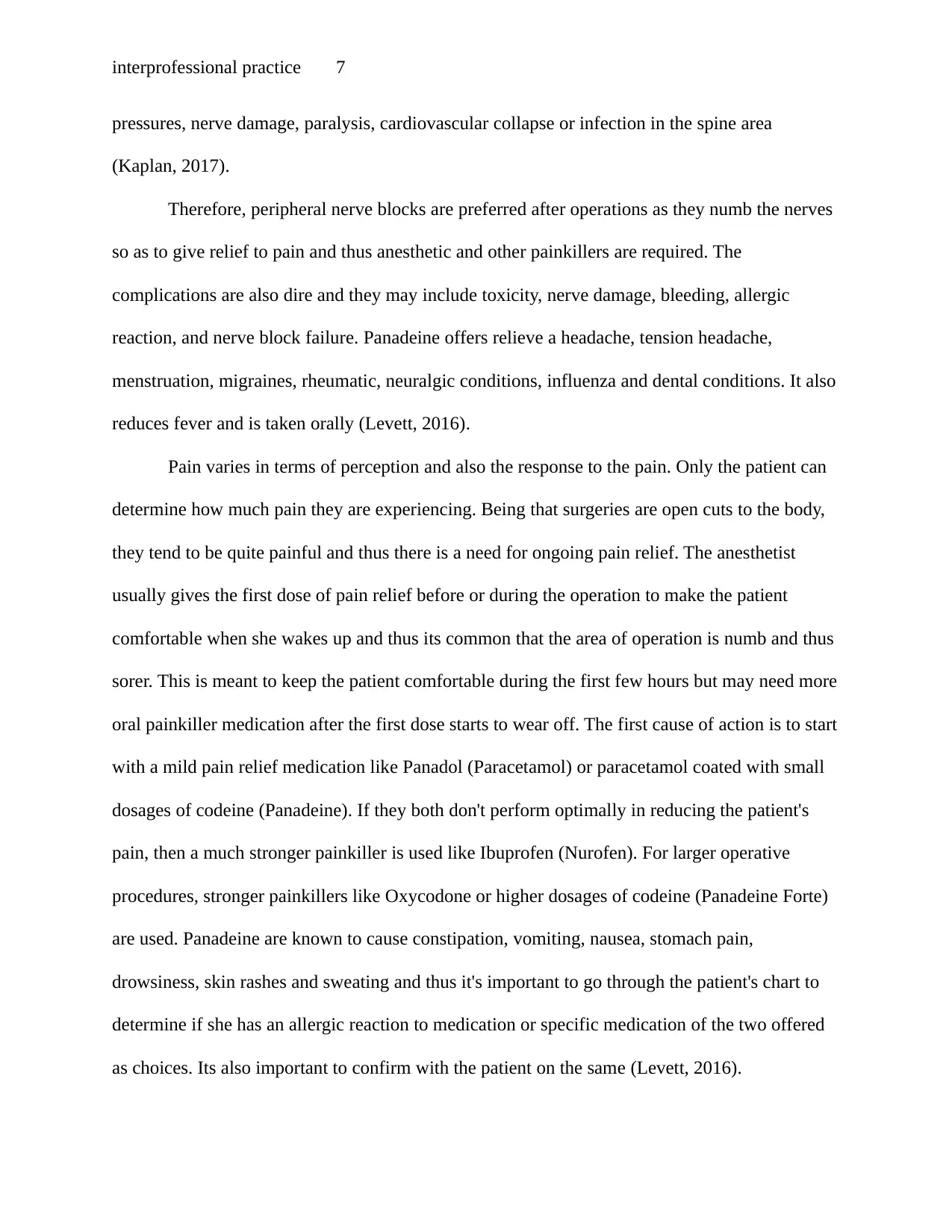
interprofessional practice 7
pressures, nerve damage, paralysis, cardiovascular collapse or infection in the spine area
(Kaplan, 2017).
Therefore, peripheral nerve blocks are preferred after operations as they numb the nerves
so as to give relief to pain and thus anesthetic and other painkillers are required. The
complications are also dire and they may include toxicity, nerve damage, bleeding, allergic
reaction, and nerve block failure. Panadeine offers relieve a headache, tension headache,
menstruation, migraines, rheumatic, neuralgic conditions, influenza and dental conditions. It also
reduces fever and is taken orally (Levett, 2016).
Pain varies in terms of perception and also the response to the pain. Only the patient can
determine how much pain they are experiencing. Being that surgeries are open cuts to the body,
they tend to be quite painful and thus there is a need for ongoing pain relief. The anesthetist
usually gives the first dose of pain relief before or during the operation to make the patient
comfortable when she wakes up and thus its common that the area of operation is numb and thus
sorer. This is meant to keep the patient comfortable during the first few hours but may need more
oral painkiller medication after the first dose starts to wear off. The first cause of action is to start
with a mild pain relief medication like Panadol (Paracetamol) or paracetamol coated with small
dosages of codeine (Panadeine). If they both don't perform optimally in reducing the patient's
pain, then a much stronger painkiller is used like Ibuprofen (Nurofen). For larger operative
procedures, stronger painkillers like Oxycodone or higher dosages of codeine (Panadeine Forte)
are used. Panadeine are known to cause constipation, vomiting, nausea, stomach pain,
drowsiness, skin rashes and sweating and thus it's important to go through the patient's chart to
determine if she has an allergic reaction to medication or specific medication of the two offered
as choices. Its also important to confirm with the patient on the same (Levett, 2016).
pressures, nerve damage, paralysis, cardiovascular collapse or infection in the spine area
(Kaplan, 2017).
Therefore, peripheral nerve blocks are preferred after operations as they numb the nerves
so as to give relief to pain and thus anesthetic and other painkillers are required. The
complications are also dire and they may include toxicity, nerve damage, bleeding, allergic
reaction, and nerve block failure. Panadeine offers relieve a headache, tension headache,
menstruation, migraines, rheumatic, neuralgic conditions, influenza and dental conditions. It also
reduces fever and is taken orally (Levett, 2016).
Pain varies in terms of perception and also the response to the pain. Only the patient can
determine how much pain they are experiencing. Being that surgeries are open cuts to the body,
they tend to be quite painful and thus there is a need for ongoing pain relief. The anesthetist
usually gives the first dose of pain relief before or during the operation to make the patient
comfortable when she wakes up and thus its common that the area of operation is numb and thus
sorer. This is meant to keep the patient comfortable during the first few hours but may need more
oral painkiller medication after the first dose starts to wear off. The first cause of action is to start
with a mild pain relief medication like Panadol (Paracetamol) or paracetamol coated with small
dosages of codeine (Panadeine). If they both don't perform optimally in reducing the patient's
pain, then a much stronger painkiller is used like Ibuprofen (Nurofen). For larger operative
procedures, stronger painkillers like Oxycodone or higher dosages of codeine (Panadeine Forte)
are used. Panadeine are known to cause constipation, vomiting, nausea, stomach pain,
drowsiness, skin rashes and sweating and thus it's important to go through the patient's chart to
determine if she has an allergic reaction to medication or specific medication of the two offered
as choices. Its also important to confirm with the patient on the same (Levett, 2016).
Paraphrase This Document
Need a fresh take? Get an instant paraphrase of this document with our AI Paraphraser
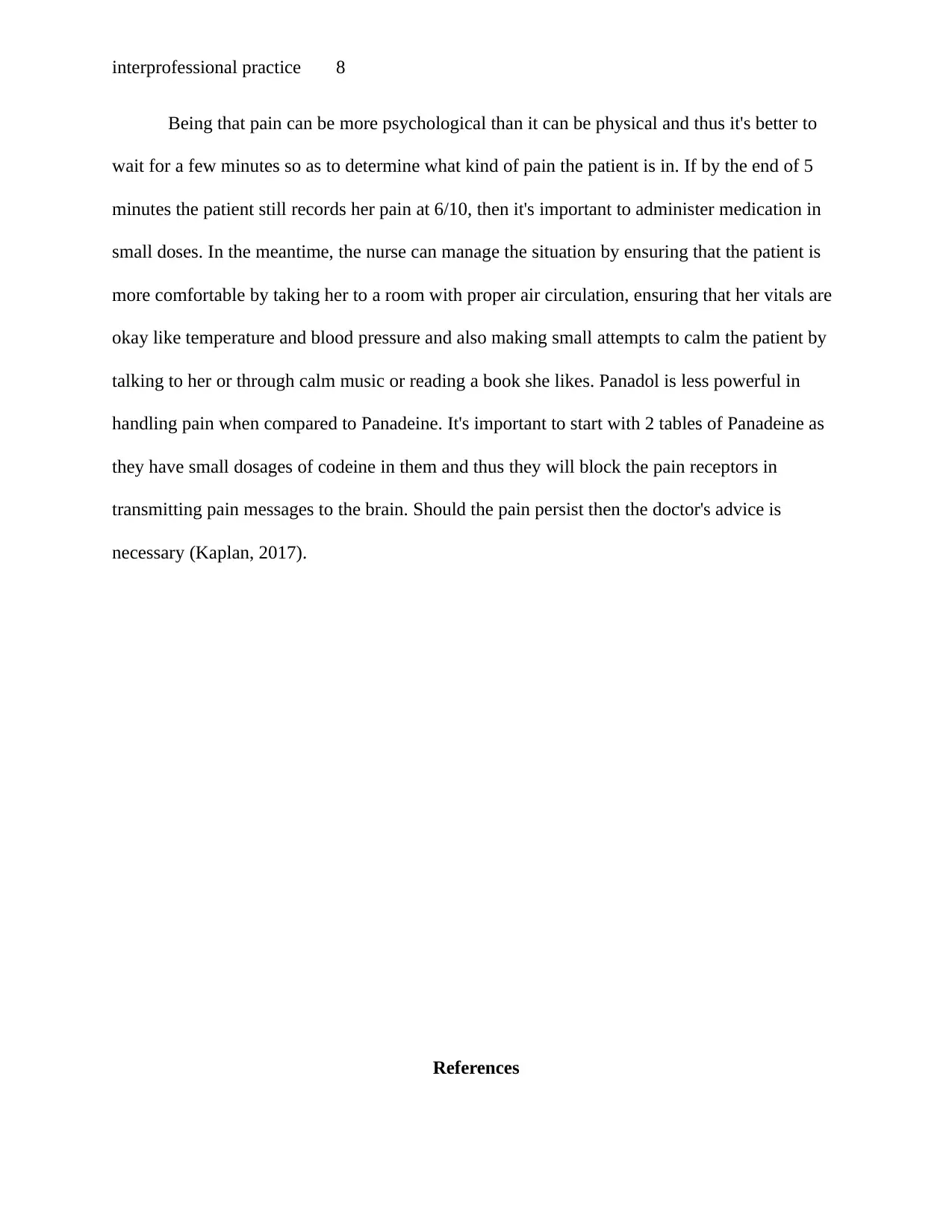
interprofessional practice 8
Being that pain can be more psychological than it can be physical and thus it's better to
wait for a few minutes so as to determine what kind of pain the patient is in. If by the end of 5
minutes the patient still records her pain at 6/10, then it's important to administer medication in
small doses. In the meantime, the nurse can manage the situation by ensuring that the patient is
more comfortable by taking her to a room with proper air circulation, ensuring that her vitals are
okay like temperature and blood pressure and also making small attempts to calm the patient by
talking to her or through calm music or reading a book she likes. Panadol is less powerful in
handling pain when compared to Panadeine. It's important to start with 2 tables of Panadeine as
they have small dosages of codeine in them and thus they will block the pain receptors in
transmitting pain messages to the brain. Should the pain persist then the doctor's advice is
necessary (Kaplan, 2017).
References
Being that pain can be more psychological than it can be physical and thus it's better to
wait for a few minutes so as to determine what kind of pain the patient is in. If by the end of 5
minutes the patient still records her pain at 6/10, then it's important to administer medication in
small doses. In the meantime, the nurse can manage the situation by ensuring that the patient is
more comfortable by taking her to a room with proper air circulation, ensuring that her vitals are
okay like temperature and blood pressure and also making small attempts to calm the patient by
talking to her or through calm music or reading a book she likes. Panadol is less powerful in
handling pain when compared to Panadeine. It's important to start with 2 tables of Panadeine as
they have small dosages of codeine in them and thus they will block the pain receptors in
transmitting pain messages to the brain. Should the pain persist then the doctor's advice is
necessary (Kaplan, 2017).
References
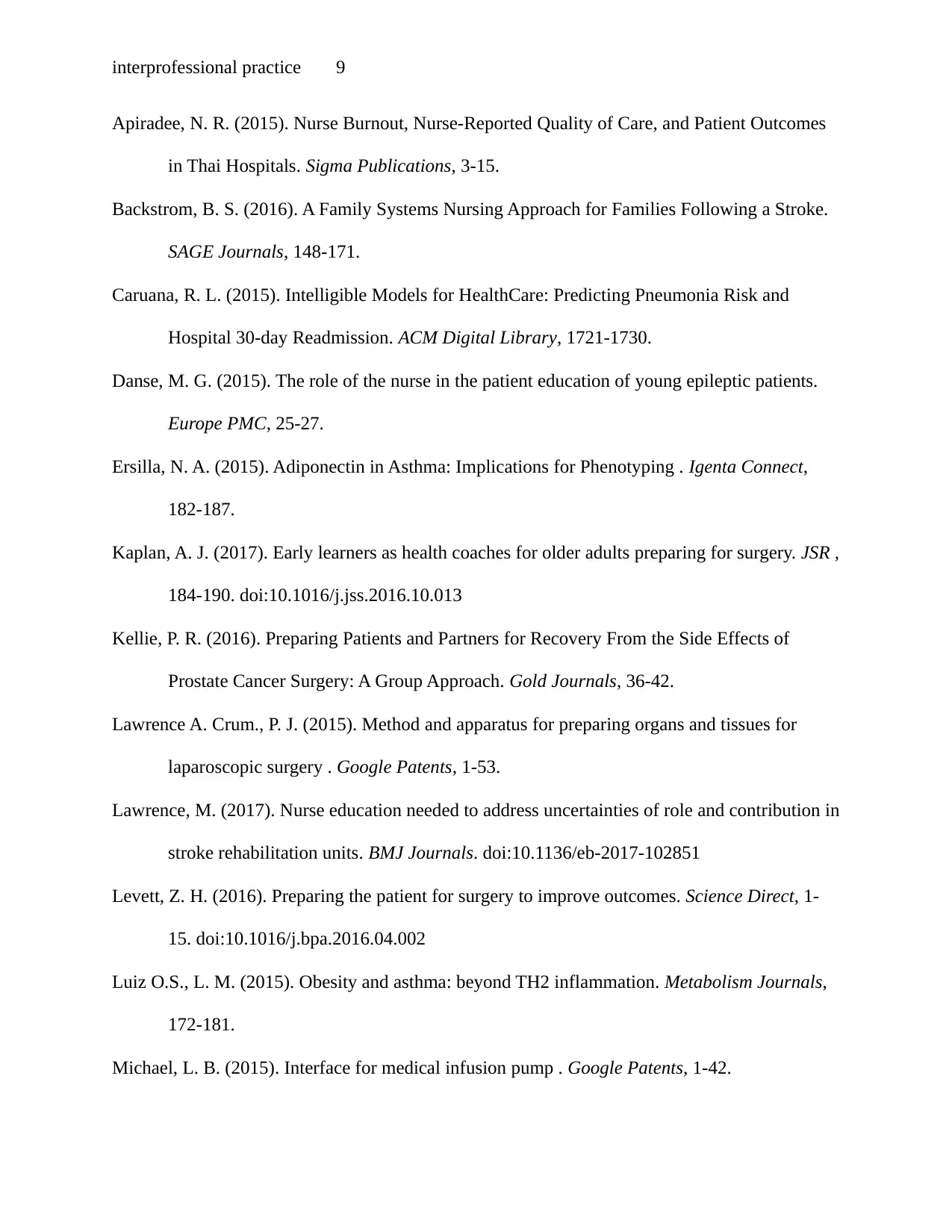
interprofessional practice 9
Apiradee, N. R. (2015). Nurse Burnout, Nurse‐Reported Quality of Care, and Patient Outcomes
in Thai Hospitals. Sigma Publications, 3-15.
Backstrom, B. S. (2016). A Family Systems Nursing Approach for Families Following a Stroke.
SAGE Journals, 148-171.
Caruana, R. L. (2015). Intelligible Models for HealthCare: Predicting Pneumonia Risk and
Hospital 30-day Readmission. ACM Digital Library, 1721-1730.
Danse, M. G. (2015). The role of the nurse in the patient education of young epileptic patients.
Europe PMC, 25-27.
Ersilla, N. A. (2015). Adiponectin in Asthma: Implications for Phenotyping . Igenta Connect,
182-187.
Kaplan, A. J. (2017). Early learners as health coaches for older adults preparing for surgery. JSR ,
184-190. doi:10.1016/j.jss.2016.10.013
Kellie, P. R. (2016). Preparing Patients and Partners for Recovery From the Side Effects of
Prostate Cancer Surgery: A Group Approach. Gold Journals, 36-42.
Lawrence A. Crum., P. J. (2015). Method and apparatus for preparing organs and tissues for
laparoscopic surgery . Google Patents, 1-53.
Lawrence, M. (2017). Nurse education needed to address uncertainties of role and contribution in
stroke rehabilitation units. BMJ Journals. doi:10.1136/eb-2017-102851
Levett, Z. H. (2016). Preparing the patient for surgery to improve outcomes. Science Direct, 1-
15. doi:10.1016/j.bpa.2016.04.002
Luiz O.S., L. M. (2015). Obesity and asthma: beyond TH2 inflammation. Metabolism Journals,
172-181.
Michael, L. B. (2015). Interface for medical infusion pump . Google Patents, 1-42.
Apiradee, N. R. (2015). Nurse Burnout, Nurse‐Reported Quality of Care, and Patient Outcomes
in Thai Hospitals. Sigma Publications, 3-15.
Backstrom, B. S. (2016). A Family Systems Nursing Approach for Families Following a Stroke.
SAGE Journals, 148-171.
Caruana, R. L. (2015). Intelligible Models for HealthCare: Predicting Pneumonia Risk and
Hospital 30-day Readmission. ACM Digital Library, 1721-1730.
Danse, M. G. (2015). The role of the nurse in the patient education of young epileptic patients.
Europe PMC, 25-27.
Ersilla, N. A. (2015). Adiponectin in Asthma: Implications for Phenotyping . Igenta Connect,
182-187.
Kaplan, A. J. (2017). Early learners as health coaches for older adults preparing for surgery. JSR ,
184-190. doi:10.1016/j.jss.2016.10.013
Kellie, P. R. (2016). Preparing Patients and Partners for Recovery From the Side Effects of
Prostate Cancer Surgery: A Group Approach. Gold Journals, 36-42.
Lawrence A. Crum., P. J. (2015). Method and apparatus for preparing organs and tissues for
laparoscopic surgery . Google Patents, 1-53.
Lawrence, M. (2017). Nurse education needed to address uncertainties of role and contribution in
stroke rehabilitation units. BMJ Journals. doi:10.1136/eb-2017-102851
Levett, Z. H. (2016). Preparing the patient for surgery to improve outcomes. Science Direct, 1-
15. doi:10.1016/j.bpa.2016.04.002
Luiz O.S., L. M. (2015). Obesity and asthma: beyond TH2 inflammation. Metabolism Journals,
172-181.
Michael, L. B. (2015). Interface for medical infusion pump . Google Patents, 1-42.
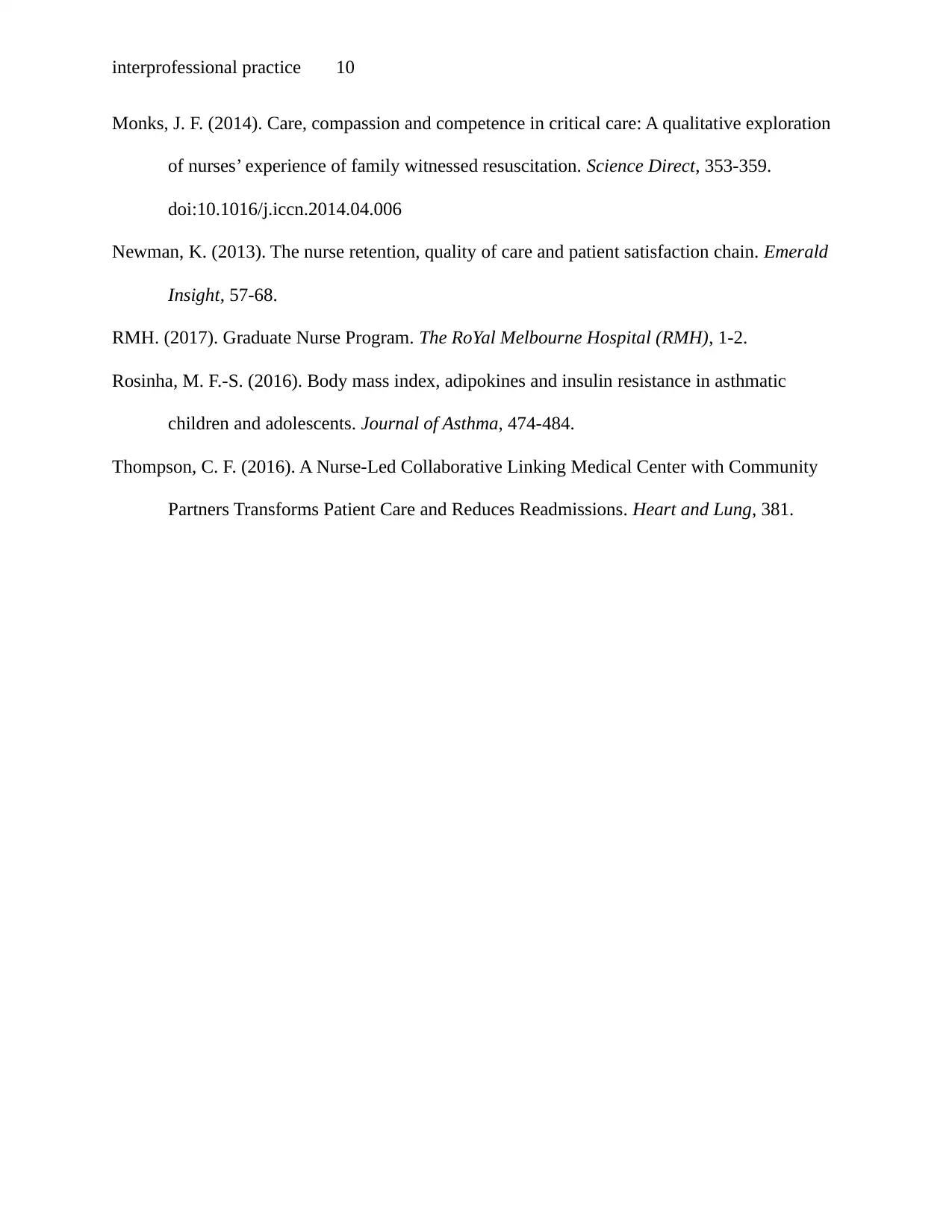
interprofessional practice 10
Monks, J. F. (2014). Care, compassion and competence in critical care: A qualitative exploration
of nurses’ experience of family witnessed resuscitation. Science Direct, 353-359.
doi:10.1016/j.iccn.2014.04.006
Newman, K. (2013). The nurse retention, quality of care and patient satisfaction chain. Emerald
Insight, 57-68.
RMH. (2017). Graduate Nurse Program. The RoYal Melbourne Hospital (RMH), 1-2.
Rosinha, M. F.-S. (2016). Body mass index, adipokines and insulin resistance in asthmatic
children and adolescents. Journal of Asthma, 474-484.
Thompson, C. F. (2016). A Nurse-Led Collaborative Linking Medical Center with Community
Partners Transforms Patient Care and Reduces Readmissions. Heart and Lung, 381.
Monks, J. F. (2014). Care, compassion and competence in critical care: A qualitative exploration
of nurses’ experience of family witnessed resuscitation. Science Direct, 353-359.
doi:10.1016/j.iccn.2014.04.006
Newman, K. (2013). The nurse retention, quality of care and patient satisfaction chain. Emerald
Insight, 57-68.
RMH. (2017). Graduate Nurse Program. The RoYal Melbourne Hospital (RMH), 1-2.
Rosinha, M. F.-S. (2016). Body mass index, adipokines and insulin resistance in asthmatic
children and adolescents. Journal of Asthma, 474-484.
Thompson, C. F. (2016). A Nurse-Led Collaborative Linking Medical Center with Community
Partners Transforms Patient Care and Reduces Readmissions. Heart and Lung, 381.
1 out of 10
Related Documents
Your All-in-One AI-Powered Toolkit for Academic Success.
+13062052269
info@desklib.com
Available 24*7 on WhatsApp / Email
![[object Object]](/_next/static/media/star-bottom.7253800d.svg)
Unlock your academic potential
© 2024 | Zucol Services PVT LTD | All rights reserved.





